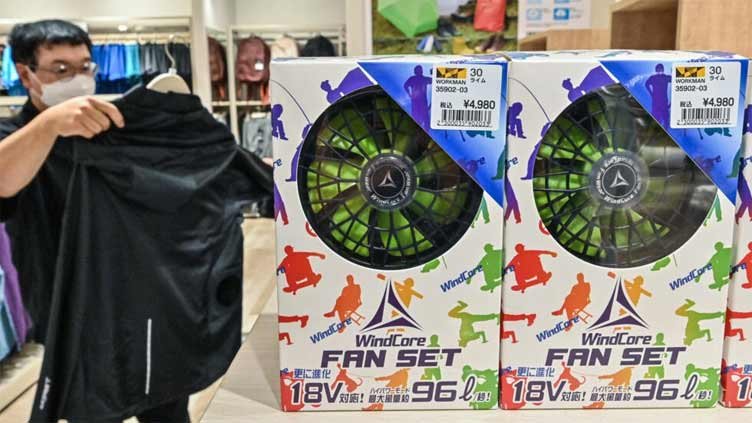By Samia Pervaiz
Amid the rising temperatures that are becoming a hallmark of the contemporary world, Japan is grappling with the intensity of its summers, mirroring a global trend. The recent July was a striking testament to this, ranking as the hottest in a century, and the consequences have been severe. Tragedy has manifested in the form of heatstroke, with the scorching conditions claiming the lives of at least 53 individuals while nearly 50,000 sought urgent medical aid. This distressing scenario has prompted ingenious solutions from innovative minds, signaling a new era where fashion and technology converge for survival.
Workman, recognized for crafting attire tailored to construction workers, embarked on an intriguing venture in 2020. With demand surging, they transformed their fan-embedded jackets into a fashionable streetwear variant. The mechanics are elegantly simple: a pair of compact electric fans, fueled by rechargeable batteries, are seamlessly integrated into the jacket’s rear. These petite powerhouses draw ambient air, channeling a refreshing breeze, modulating its speed based on preference, and caressing the wearer’s body. These innovative garments are attainable at a retail price range of 12,000 to 24,000 yen ($82-164), a small investment for beating the relentless heat.
Yuya Suzuki, the spokesperson for Workman, highlighted the changing consumer dynamics in the face of climatic adversity. “As temperatures soar, individuals previously unacquainted with fan-equipped clothing are actively seeking ways to temper the heat. This surge in interest has prompted more people to consider purchasing our product,” Suzuki stated. The allure of such attire is not solely practical; it carries an intangible yet unmistakable comfort akin to being enveloped in the soothing embrace of a domestic fan. It’s a feeling of cool serenity, a personal oasis amid the sweltering chaos.
While Tokyo’s summer has always been known for its high mercury levels, July’s record average temperature of 28.7 degrees Celsius (83.7 degrees Fahrenheit) set a new scorching benchmark since 1875. The implications of such heat extend beyond discomfort, turning deadly. Heatstroke, a perilous condition, takes a particularly harsh toll in Japan, a country facing the dual challenges of being a summer inferno and having one of the world’s oldest populations, second only to Monaco. Astonishingly, over 80 percent of heat-related fatalities over the last five years have impacted senior citizens, underscoring the urgency of protective measures.
In the relentless pursuit of solutions, companies like MI Creations have taken center stage. Their innovative neck-cooling tubes, valued at 2,500 yen, have garnered attention. Nozomi Takai, representing MI Creations, explained their efficacy. The gel encased within the vibrant tubes, following a brief sojourn in the fridge, dispenses a cooling sensation that can provide relief for up to an hour when worn around the neck. A singular solution with a profound impact, these tubes can significantly mitigate the overall body temperature, offering respite from the sweltering elements.
The quest for remedies against the oppressive heat led to a notable event – an expo focused on combating extreme heat in Tokyo. At this gathering, various pioneering companies unveiled their innovations aimed at ensuring individuals remain cool in the face of adversity. Among these visionaries is Liberta, a Tokyo-based enterprise, showcasing an assortment of garments such as T-shirts and arm sleeves embellished with prints that evoke a sense of coolness. These prints ingeniously interact with sweat, creating a refreshing sensation and offering a fashionable defense against the heat.
In a world marred by soaring temperatures and the perils they entail, Japan’s response exemplifies the convergence of necessity and innovation. The interplay of fashion and technology, as seen through fan-fitted jackets, cooling neck tubes, and inventive prints, reflects a society driven to adapt. As summer’s heat persists and the threat intensifies, these pioneering solutions become beacons of hope, ensuring that style and substance unite to defy nature’s fiercest challenges.
Amid the sweltering heatwaves that grip Japan and much of the world, innovative approaches to staying cool have blossomed, bringing a blend of fashion and technology to the forefront. Employing ingenious materials like xylitol, renowned for inducing a refreshing sensation when interacting with water and sweat, forward-thinking companies have woven these components into intricate prints. Chikuma, hailing from Osaka, has taken cooling attire a step further, unveiling office jackets and dresses adorned with miniature electric fans. This unconventional attire has found a niche in environments where casual wear is typically frowned upon, presenting a novel solution to the relentless heat.
Yosuke Yamanaka, a representative from Chikuma, illuminated the innovation behind their creations. Recognizing the common issue of conventional fan-fitted garments appearing bulky, Yamanaka disclosed their breakthrough. Collaborating with power tool manufacturer Makita and textile titan Teijin, they devised a unique structure that sandwiches the fans between two layers, effectively capturing the cooling air and eliminating the need for constraining zippers and cuffs. This pioneering endeavor represents a convergence of comfort and style, redefining what practical clothing can achieve in the face of extreme weather.
The evolution of cooling strategies is not confined to attire alone; it extends to cultural norms and societal perceptions. Parasols, traditionally associated with women seeking to guard their skin from the sun’s embrace, have witnessed an intriguing shift. A renowned luxury umbrella maker in Tokyo, Komiyama Shoten, embarked on a transformative journey around 2019 when the environment ministry advocated for broader parasol use. Hiroyuki Komiya, the company’s owner, revealed the significant change in perception among male customers. In the past, many dismissed parasols as a symbol for women, but today, men have embraced these protective accessories with fervor.
The bustling streets of Asakusa, a popular tourist destination, offer a glimpse into the changing tides of comfort. Kiyoshi Miya, a 42-year-old visitor, decided to turn his umbrella into a makeshift parasol, finding solace in the cool shade it provides amid the scorching sun. His sentiment resonates with Shoma Kawashima, a 21-year-old who opted for a wearable fan to tame the relentless heat. Kawashima’s candid admission, “It’s so hot I want to be naked,” captures the raw reality of confronting soaring temperatures. While gadgets and innovations offer respite, Kawashima astutely observes that they are but fragments in the larger mosaic of tackling rising temperatures.
The fusion of practicality and fashion signifies a broader societal transformation. With heatwaves on the rise, these inventive solutions underscore a collective endeavor to adapt and thrive amid adversity. From innovative fan-fitted attire to the expanding acceptance of parasols among men, these changes mirror the broader quest for comfort and well-being. As technology and culture intertwine, a new narrative emerges, one that revolves around equipping individuals to face the formidable challenges posed by a changing climate. While not the panacea, these solutions resonate as tangible steps toward a cooler, more comfortable future.
In the face of escalating temperatures, the marriage of fashion and technology has birthed ingenious solutions to combat the sweltering heat. From fan-fitted jackets to stylish parasols, these innovations not only offer respite from scorching summers but also challenge traditional norms of gender and attire. While these cooling trends have captured attention and provided momentary relief, they serve as a reminder that fashion’s response to rising temperatures is a dynamic process, requiring ongoing innovation and adaptation. As we embrace these inventive approaches, it’s clear that staying cool and comfortable is not just a matter of style, but a testament to our ability to blend creativity and practicality in the pursuit of comfort.
Subscribe our website for latest updates:
https://republicpolicy.com/shop/
Read More















